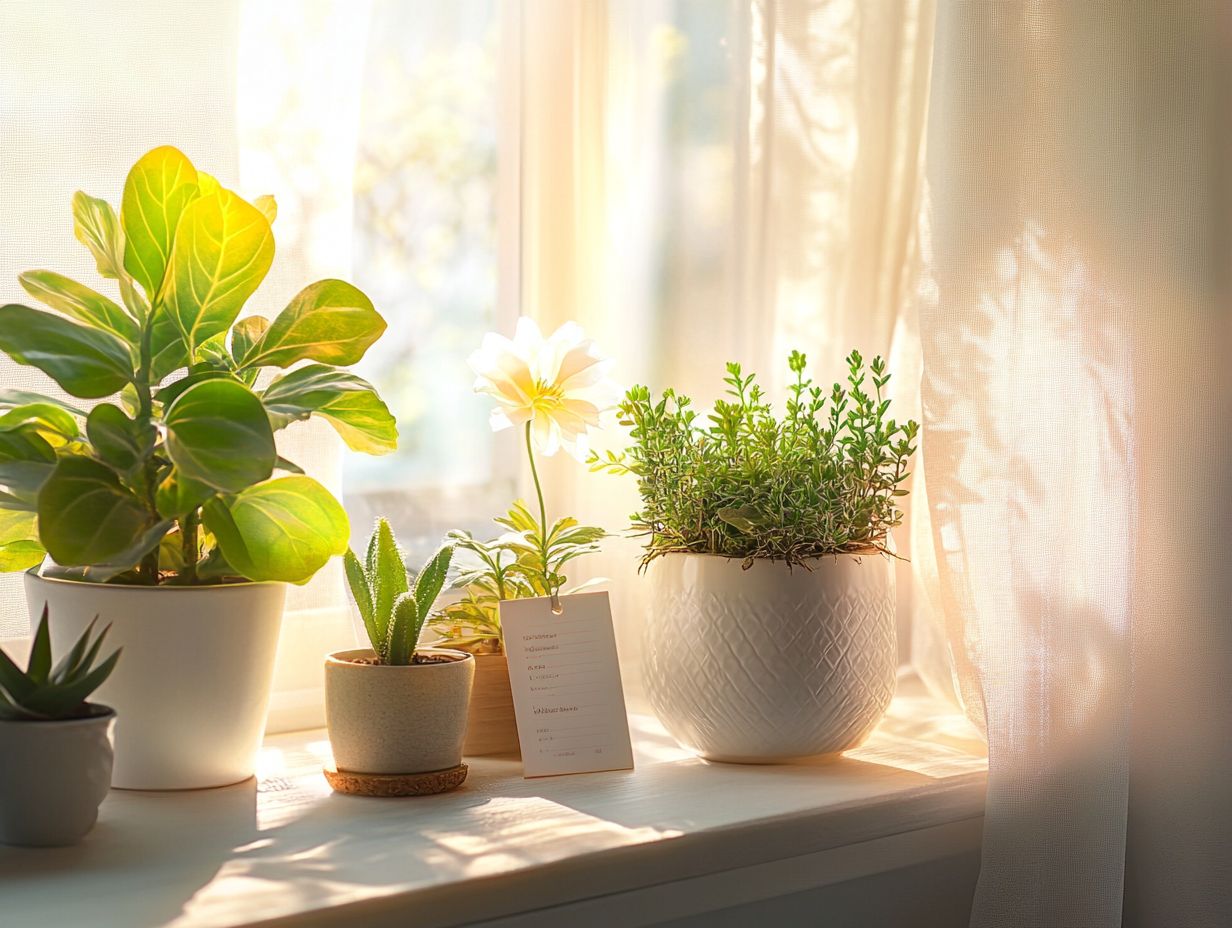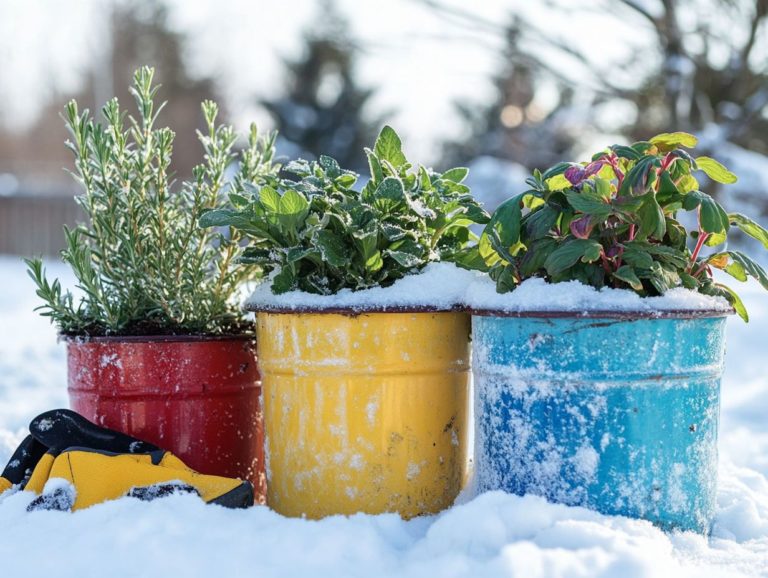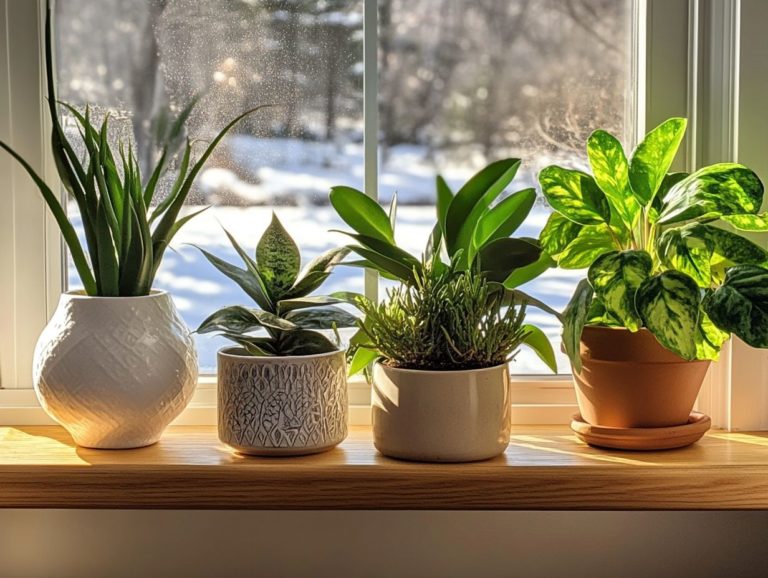Maximizing Light for Indoor Winter Plants
Light plays a crucial role in the growth of your plants, impacting everything from photosynthesis to their overall vitality.
As winter draws near, you may encounter the challenge of insufficient natural light, which can impede your plants’ development. This article delves into the significance of light for your plants, the limitations of winter sunlight, and the diverse range of artificial lighting options available to you.
You’ll also find valuable tips for choosing the right artificial lighting, maximizing exposure, and steering clear of common pitfalls. This ensures that your indoor garden flourishes even in the chillier months.
Contents
- Key Takeaways:
- Understanding the Role of Light for Plants
- Challenges of Indoor Winter Plant Growth
- Types of Artificial Light for Plants
- How to Choose the Right Light for Your Plants
- Tips for Maximizing Light for Indoor Winter Plants
- Common Mistakes to Avoid
- Frequently Asked Questions
- 1. How can I maximize light for my indoor plants during the winter?
- 2. What types of plants are best for indoor winter growing?
- 3. How long should I leave my grow lights on for indoor winter plants?
- 4. Do all plants need the same amount of light during the winter?
- 5. Can I use regular household light bulbs for my indoor winter plants?
- 6. Can I move my plants closer to a window during the winter for more light?
Key Takeaways:

- Proper light is essential for healthy plant growth, especially in the winter when natural light is limited.
- Different types of artificial light sources, such as LED grow lights and traditional grow lights, have varying benefits.
- Strategic placement and regular maintenance of artificial lights can maximize their effectiveness for indoor winter plants.
Understanding the Role of Light for Plants
Light is crucial for plant growth as it acts as the primary energy source that fuels photosynthesis. This process allows plants to transform light energy into chemical energy.
This transformation is essential for the growth, development, and overall health of plants, especially indoor varieties where natural sunlight might be lacking. Understanding terms like light quality and spectrum can help you make better choices about supplemental lighting, ultimately creating optimal growth conditions for both leafy greens and flowering plants.
Why Light is Essential for Plant Growth
Light is absolutely essential for plant growth, as it fuels the process of photosynthesis. This process allows plants to synthesize nutrients and produce energy, which is critical for their overall development.
The intensity and quality of light can significantly influence how effectively your plants convert light energy into chemical energy. Different wavelengths of light play unique roles; for example, blue light supports vegetative growth, while red light is crucial for flowering.
Chlorophyll, the pigment responsible for capturing light energy, absorbs these specific wavelengths and kicks off the photosynthetic process. This knowledge is particularly valuable for houseplant enthusiasts like you.
The varying light conditions in indoor environments can lead to differences in growth rates and plant health. Ensuring that your plants receive the right light intensity and duration can make a substantial difference in their vitality and overall appearance.
Challenges of Indoor Winter Plant Growth
Indoor winter plant growth poses distinct challenges, primarily stemming from the limited natural light and how seasonal changes influence plant needs. This can result in leggy growth and a decline in the overall health of your houseplants.
Limitations of Natural Light
The limitations of natural light during those long winter months can create serious challenges for your indoor plants’ thriving game. Insufficient light intensity and duration restrict their growth and vitality in ways that can be frustrating for any indoor gardener.
Understanding how various houseplants respond to these changes in light is crucial for your success. For instance, resilient plants like snake plants and pothos tend to adapt well to lower light conditions, while others might show signs of stress or decline.
You can take action now by rotating your plants for maximum light exposure, using grow lights to supplement natural light, or choosing species that thrive in low-light environments. By being aware of each plant’s specific needs, you can cultivate a flourishing indoor ecosystem that not only enhances your well-being but also elevates the beauty of your living space.
Types of Artificial Light for Plants

You have a variety of artificial lighting options for indoor plants. These range from traditional grow lights to cutting-edge LED grow lights and Smart Garden systems.
Each of these choices presents distinct advantages. They are expertly tailored to optimize the light spectrum for the health and growth of your plants, enhancing energy efficiency.
Comparison and Benefits of Different Light Sources
When you compare different light sources like traditional grow lights and energy-efficient LED options you’ll uncover the advantages of each. This is especially true regarding energy efficiency and light quality.
Each light source boasts unique characteristics that can profoundly impact your plants’ health and development. For example, traditional grow lights typically emit a broader light spectrum. This can be beneficial for flowering plants that thrive under higher light conditions.
However, traditional lights often consume more energy and generate excess heat. This can be harmful to more sensitive species. In contrast, LEDs offer a targeted spectrum tailored to various growth stages while using significantly less energy.
This makes LEDs particularly well-suited for leafy greens. As a plant enthusiast, it’s crucial to assess your specific plant types and their growth requirements. This ensures you achieve optimal results.
How to Choose the Right Light for Your Plants
Selecting the perfect light for your plants requires a clear understanding of their individual light requirements. You need to know whether they flourish in low, medium, or high light conditions.
It’s also important to consider factors like light quality and duration. This will help you create the ideal environment for their growth.
Factors to Consider and Tips for Selection
When choosing the right light for growing plants indoors, keep essential factors in mind. These include light intensity, light duration, and the specific needs of the plants you re cultivating.
Understanding these parameters can greatly enhance your plants’ overall health. First, assess their individual preferences do they thrive in low, medium, or bright light conditions? A light meter, a tool that measures how much light is in a space, can offer valuable insights.
Implementing common indoor gardening practices can also be beneficial. For instance, rotating your plants regularly ensures they receive even exposure to light from all angles. Positioning them strategically near windows will help you maximize natural sunlight.
Additionally, regularly observing your plants’ health will guide you in making future adjustments to their light exposure.
Tips for Maximizing Light for Indoor Winter Plants
Maximizing light for your indoor winter plants requires thoughtful placement and maintenance strategies that enhance exposure. By considering where you position your plants, you can learn more about maximizing sunlight in your cold-climate garden to ensure they receive the essential light needed for optimal growth during those less sunny months.
Placement and Maintenance Strategies

Effective placement and maintenance strategies are vital for ensuring that your indoor plants receive the light exposure they need. This caters to their specific requirements and promotes healthy growth.
Thoughtfully positioning your plants near south-facing windows can significantly maximize their sunlight exposure. This is essential for many varieties. Using plant stands can be a game-changer. They lift your greenery closer to those precious light sources and prevent leggy growth.
It s crucial for you, as a plant enthusiast, to monitor the quality of light your plants receive. Make adjustments as needed. Timers can be an excellent tool to guarantee consistent light exposure, even when natural sunlight fluctuates.
Finally, rotating your plants regularly allows all sides to enjoy ample light. This fosters uniform growth and ensures your botanical friends thrive.
Don’t wait! Optimize your plant’s growth now by implementing these tips. Try them today and watch your indoor garden flourish!
Common Mistakes to Avoid
Avoiding common mistakes in indoor gardening is essential for nurturing healthy plants. Inadequate light exposure can result in leggy growth and a decline in overall plant vitality.
Being mindful of these pitfalls helps you grow a thriving indoor garden that flourishes beautifully, addressing their light needs.
Pitfalls that can Negatively Impact Plant Growth
Common pitfalls that can adversely affect your plants include insufficient light levels, improper watering, and a lack of attention to seasonal changes in their light needs.
These issues can lead to a host of problems, such as stunted growth, leaf discoloration, and increased vulnerability to pests and diseases. For example, if your plants are in low light conditions, the process plants use to make food will suffer, making them weak and leggy. Check your plants light needs now to keep them healthy and happy!
Inconsistent watering practices can spell disaster, resulting in either root rot or dehydration both of which can severely compromise your plants health. Establishing a diligent watering schedule that caters to the specific needs of each species is vital.
Understanding seasonal changes in light exposure helps your plants thrive. It ensures they receive the optimal conditions for growth they need throughout the year, fostering vigorous growth, healthy plant development, and resilience in challenging indoor environments.
Frequently Asked Questions
1. How can I maximize light for my indoor plants during the winter?
To maximize light for indoor winter plants, you can place them near a south-facing window where they will receive the most sunlight. You can also use artificial grow lights, such as LED grow lights, to supplement natural light and ensure optimal growth.
2. What types of plants are best for indoor winter growing?

Plants that thrive in low light conditions, such as pothos, snake plant, and peace lily, are ideal for indoor winter growing. These plants can tolerate lower light levels and still thrive, making them great choices for dark places in your home.
3. How long should I leave my grow lights on for indoor winter plants?
The amount of time you leave your grow lights on will depend on the specific needs of your plants. As a general rule, most plants will need 12-16 hours of light per day for optimal growth, so consider their specific light needs and growth requirements.
4. Do all plants need the same amount of light during the winter?
No, different plants have different light requirements, such as high light, medium light, or low light, which can impact their health and growth. Some may need more light than others, while others may thrive in lower light levels. It’s essential to research the specific light needs of your plants and adjust accordingly.
5. Can I use regular household light bulbs for my indoor winter plants?
No, regular household light bulbs do not provide the full spectrum of light that plants need for photosynthesis. It’s best to use specialized grow lights or full-spectrum LED lights for indoor plants, as they provide the necessary light spectrum for photosynthesis and nutrient absorption.
6. Can I move my plants closer to a window during the winter for more light?
Yes, you can move your plants closer to a window to receive more natural light during the winter. Just make sure to check the temperature and drafts near the window, as extreme temperature changes, along with low humidity, can be harmful to plants. Monitor their environment carefully.






